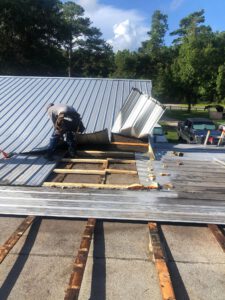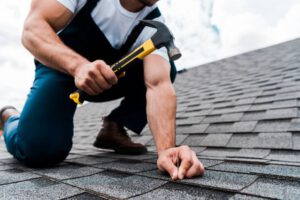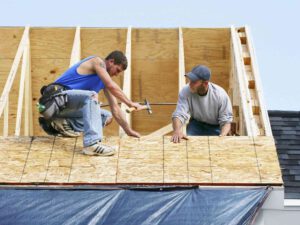Your roof is an important component of your home and needs to be installed correctly. It protects your house from moisture intrusion, and leaks can lead to significant damage inside your home.

Roofing is not something you want to try yourself. It requires specialized equipment and expertise to do properly.
The roof is one of the most visible parts of a home and can add to or detract from its overall appearance. Updating the roofing material can improve a home’s look and increase its value. In addition, new roofing materials can improve energy efficiency, protect against moisture and add a range of new features.
There are many types of roofing materials available, including clay tiles, concrete tiles and shingles. Clay and concrete tiles add a rustic, elegant look to a roof while providing durability, and they work well with Mediterranean, Mission and Southwestern-style homes. However, they are expensive and heavy, requiring additional framing for support.
Asphalt shingles are affordable and provide excellent protection in most climates. They are also easy to repair and come in a variety of styles, colors and finishes. Other options include wood shingles, metal shingles and slate shingles. Slate is a durable option that adds a natural, classy touch to a home’s exterior, but it is also expensive and requires specialized framing.
A new roof can protect a home from damage caused by weather and can significantly improve its curb appeal. Re-roofing provides a good opportunity to add or upgrade other outdoor features, such as solar panels and green roofs.
To complete a roofing project, a contractor needs a number of tools and supplies. Pry bars are used to remove nails, staples and other fasteners that hold down old roofing materials. Protective workwear includes hard hats, eyewear and gloves. A tape measure is useful for measuring lengths and angles, while a chalk line helps to snap straight lines on the roof. A roofer may also need to install roof brackets or toe boards on steep roofs, which provide footing and help prevent falls.
Underlayment
Underlayment provides a second layer of protection to prevent leaks under the shingles. It also helps to keep the roof deck dry before shingles go on, protects against wind-driven rain as shingles fail and increases fire resistance. Roofers install the underlayment overlapping the edges of the previous row. After the underlayment is in place, they install a drip edge on the roof’s sides to help direct water into gutters rather than over the edges of the new shingles.
In floor coverings, underlayment is a soft material that goes directly underneath the surface or floor covering and above the subfloor. It can be made from either a soft or hard material, depending on the type of floor covering you choose. Cork and foam are common soft underlayments, while cement board is a popular hard underlayment.
The underlayment can be nailed, taped or glued to the subfloor. Some styles even feature a peel-and-stick application, making the installation process quicker and easier. When choosing an underlayment, you should keep in mind that thicker underlayments will raise the level of the floor. This can cause problems with transitions between rooms or with door and trim sizes.
Before beginning your roofing project, cover movable items near the house with large tarps to protect them from falling shingles and debris. Consider relocating any plants or landscaping near the home as well, and invest in a fall-protection kit to ensure you don’t suffer injuries from working on a steep or high roof. It’s best to leave roofing and other high-up projects to professionals who have the proper safety equipment and training. This will save you time, money and stress in the long run.
Flashing
Flashing is the thin material used to seal and protect areas of a roof where it meets other surfaces, such as walls or chimneys. This helps prevent water penetration and other damage to the structure. Flashing can be made of metal or non-metal, depending on the application.
For example, metal flashing can be used to close a joint between the roofing and the wall, or where a roof slope changes direction. It is also often found around roof vents, skylights, chimneys and other protrusions. Flashing can be exposed or concealed, and it can be made of lead, aluminum, copper or zinc alloy.
Some examples of roof flashing include valley flashing, pipe flashing and step flashing. Valley flashing is used in the area where two roof slopes meet to direct water away from the seams. This can be one piece of continuous flashing or multiple overlapping pieces, such as step flashing. Pipe flashing resembles a collar that wraps around a pipe’s diameter to create a seal. It is sometimes made of rubber instead of metal for easier expansion and contraction.
Step flashing is created by bending rectangles of metal into an L-shape, and then nailing them together along the edge of a dormer or other protrusion on a roof. The bottom of the L is nailed to the roof, while the top is nailed to the vertical wall.
Another type of flashing is kickout flashing, which is installed in the area where the step flashing ends and the gutter begins. This bridges the gap and helps to guide water away from the home and into the gutter. Roof flashing is a vital part of every roof system and must be properly installed to keep water out of the home. If it is not, you could end up with a leaky roof and costly repairs.
Shingles
Depending on the type of roofing, some form of felt paper or a special waterproof underlayment should be laid over the roof deck. If you opt to use an ice and water barrier, it should be applied at this point as well. Water leaks can occur where the shingle layer is penetrated or interrupted, such as where a wall meets the roof or where a valley is located on the roof. The best time to apply this product is while the sheathing is dry, and the weather is warm and not windy.
Before you begin shingling, take some time to chalk vertical reference lines across the roof. This will help you keep the shingles straight and even as you work your way across the surface of the roof. Many roofing professionals start shingling at the left eave and work their way toward the peak, using the roof’s natural curve to guide them. It is also a good idea to snap a line across the first course of shingles that you are working on for reference, especially if your roof has a steep slope.
If your roof has open valleys, this is the ideal time to complete them with a sheet of pre-formed metal flashing. You can also choose to have the valleys completed as shingle courses approach them, but IKO recommends that this option be used only if your roof has an adequate slope.
You can use shingles of any color you like, but asphalt shingles are the most common and affordable choice. For the first row, cut the tabs off a three-tab shingle to create a starter strip. This strip should extend a little past the drip edge of the roof and be nailed down. The rest of the shingles should be placed in consecutive rows up to the ridge of the roof, with the end nails being covered by up to 1/2 of a tab of the shingle below.
Ladder
Ladders are one of the most commonly used tools around the house and for many professions and trades. Yet, despite their ubiquitous use, many people are not familiar with the different parts of a ladder, including its various sizes and functions. This handy infographic from the team at Ladders UK Direct helps explain the most popular types of ladders and their different parts. It also discusses ladder safety tips to help you stay safe while using a ladder.
There are many different types of ladders to choose from, depending on the specific needs of your job. For instance, an extension ladder can be used to reach high spaces that are too far to reach with a standard step ladder. It has multiple length sections that can be slid together for storage or extended to increase the ladder’s height. The ladder can even be positioned to take the shape of an A-frame for added versatility.
Another type of ladder is a telescoping ladder, which has similar features to an extension ladder but uses pins rather than a sliding system. It is more portable than a regular extension ladder and can be set up on uneven surfaces, making it ideal for jobs in tight spaces. However, ladder levels should be used with these ladders to ensure that they are secure and stable.
Metal ladders are a common choice for industrial and home projects, but it’s important to choose the right ladder for each job. For example, aluminum ladders should not be used near electrical work because they conduct electricity. Wooden ladders, on the other hand, are non-conductive and can be used in almost any context. They’re also durable, although they may be less portable than other ladders.






